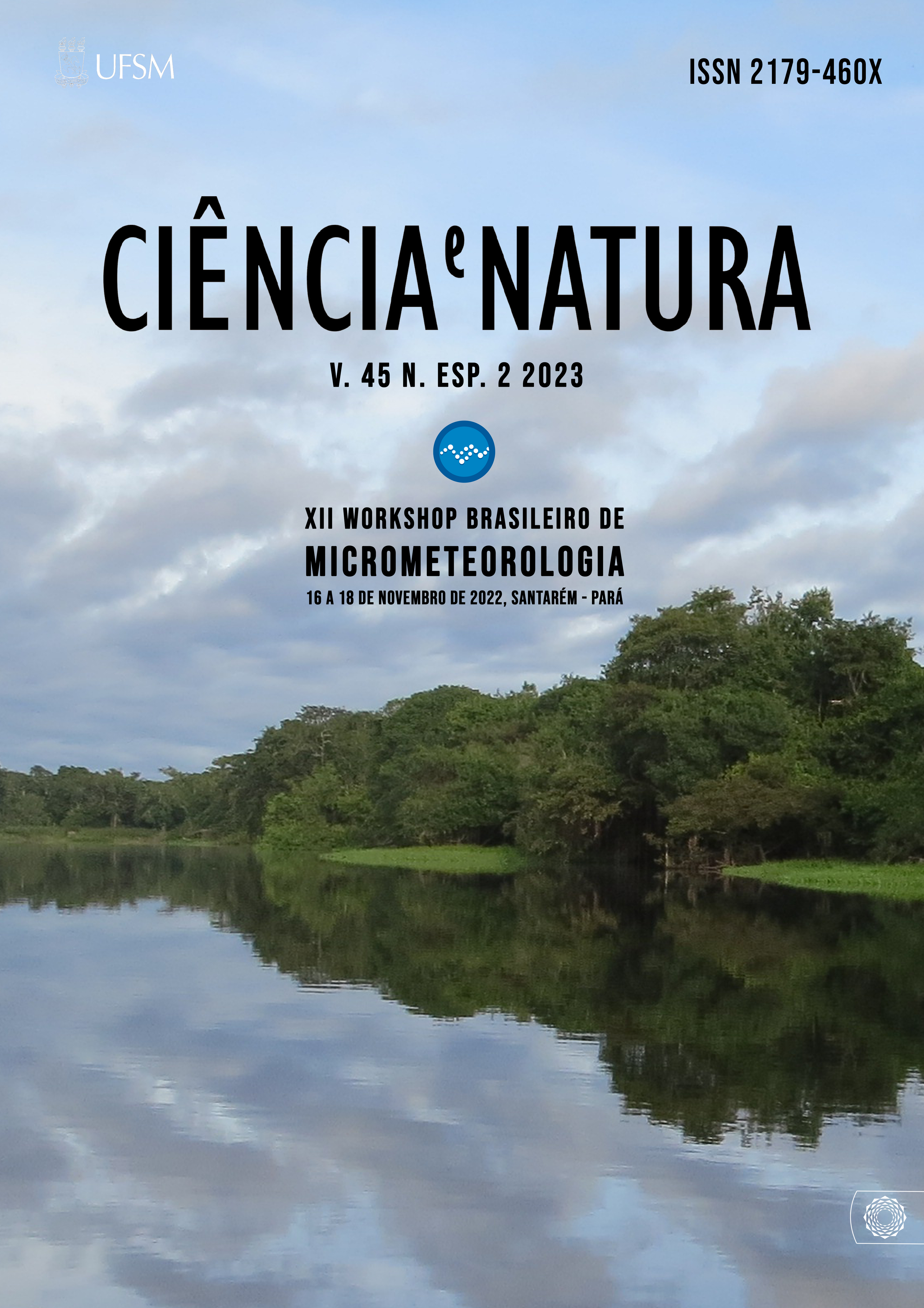Análise de sinais de alerta antecipados durante a ocorrência de fenômenos atmosféricos extremos em diferentes sítios experimentais da Amazônia
DOI:
https://doi.org/10.5902/2179460X75415Palavras-chave:
Atmosfera tropical, Camada limite noturna, Sinais de alerta antecipadosResumo
Foram investigados fenômenos atmosféricos extremos que se manifestam na forma de variações abruptas na velocidade do vento e na temperatura. Durante a ocorrência dessas variações e com o uso do método de Sinais de Alerta Antecipados (SAA), é possível a detecção da transição entre dois regimes de turbulência na Camada Limite Noturna (CLN). Os testes foram realizados tendo como variável de estado a temperatura potencial. Como resultado, foi possível identificar casos de fenômenos atmosféricos extremos que ocorreram nos três sítios investigados, além disso detectou-se a ocorrência de SAA na CLN amazônica.
Downloads
Referências
ACEVEDO, O. C., MAHRT, L., PUHALES, F. S., COSTA, F. D., MEDEIROS, L. E., & DEGRAZIA, G. A. (2016). Contrasting structures between the decoupled and coupled states of the stable boundary layer. Quarterly Journal of the Royal Meteorological Society, 142(695), 693-702. DOI: https://doi.org/10.1002/qj.2693
Dakos, V., Scheffer, M., van Nes, E. H., Brovkin, V., Petoukhov, V., & Held, H. (2008). Slowing down as an early warning signal for abrupt climate change. Proceedings of the National Academy of Sciences, 105(38), 14308-14312. DOI: https://doi.org/10.1073/pnas.0802430105
Dakos, V., Carpenter, S. R., Brock, W. A., Ellison, A. M., Guttal, V., Ives, A. R., ... & Scheffer, M. (2012). Methods for detecting early warnings of critical transitions in time series illustrated using simulated ecological data. PloS one, 7(7), e41010. DOI: https://doi.org/10.1371/journal.pone.0041010
Farias, F. O. M. (2017).Detecção de fenômenos extremos na camada limite atmosférica noturna acima da floresta Amazônica a partir da análise de sinais precursores (Tese de Doutorado). Instituto Nacional de Pesquisas da Amazônia, Manaus, Brasil.
Lenton, T. M. (2011). Early warning of climate tipping points. Nature Climate Change, 1(4), 201-209. DOI: https://doi.org/10.1038/nclimate1143
Lenton, T. M., Livina, V. N., Dakos, V., Van Nes, E. H., & Scheffer, M. (2012). Early warning of climate tipping points from critical slowing down: comparing methods to improve robustness. Philosophical Transactions of the Royal Society A, 370(1962), 1185-1204. DOI: https://doi.org/10.1098/rsta.2011.0304
Miranda, F. O., Ramos, F. M., von Randow, C., Dias-Júnior, C. Q., Chamecki, M., Fuentes, J. D., Manzi, A. O., Oliveira, M. E. de & de Souza, C. M. (2020a). Detection of extreme phenomena in the stable boundary layer over the Amazonian Forest. Atmosphere, 11(9), 952. DOI: https://doi.org/10.3390/atmos11090952
Miranda, F. O., Sá, L. D. de A., Randow, C. von, Ramos, F. M., & Manzi, A. O. (2020b). Wind speed peaks and their relationship with the increase of scalar flows in the tropical night atmosphere: a case study. Ciência E Natura, 42, e12. DOI: https://doi.org/10.5902/2179460X45354
Sun, J., Mahrt, L., Banta, R. M., & Pichugina, Y. L. (2012). Turbulence regimes and turbulence intermittency in the stable boundary layer during CASES-99. Journal of the Atmospheric Sciences, 69(1), 338-351. DOI: https://doi.org/10.1175/JAS-D-11-082.1
Downloads
Publicado
Como Citar
Edição
Seção
Licença
Copyright (c) 2023 Ciência e Natura

Este trabalho está licenciado sob uma licença Creative Commons Attribution-NonCommercial-ShareAlike 4.0 International License.
Para acessar a DECLARAÇÃO DE ORIGINALIDADE E EXCLUSIVIDADE E CESSÃO DE DIREITOS AUTORAIS clique aqui.
Diretrizes Éticas para Publicação de Revistas
A revista Ciência e Natura está empenhada em garantir a ética na publicação e na qualidade dos artigos.
A conformidade com padrões de comportamento ético é, portanto, esperada de todas as partes envolvidas: Autores, Editores e Revisores.
Em particular,
Autores: Os Autores devem apresentar uma discussão objetiva sobre a importância do trabalho de pesquisa, bem como detalhes e referências suficientes para permitir que outros reproduzam as experiências. Declarações fraudulentas ou intencionalmente incorretas constituem comportamento antiético e são inaceitáveis. Artigos de Revisão também devem ser objetivos, abrangentes e relatos precisos do estado da arte. Os Autores devem assegurar que seu trabalho é uma obra totalmente original, e se o trabalho e / ou palavras de outros têm sido utilizadas, isso tem sido devidamente reconhecido. O plágio em todas as suas formas constitui um comportamento publicitário não ético e é inaceitável. Submeter o mesmo manuscrito a mais de um jornal simultaneamente constitui um comportamento publicitário não ético e é inaceitável. Os Autores não devem submeter artigos que descrevam essencialmente a mesma pesquisa a mais de uma revista. O Autor correspondente deve garantir que haja um consenso total de todos os Co-autores na aprovação da versão final do artigo e sua submissão para publicação.
Editores: Os Editores devem avaliar manuscritos exclusivamente com base no seu mérito acadêmico. Um Editor não deve usar informações não publicadas na própria pesquisa do Editor sem o consentimento expresso por escrito do Autor. Os Editores devem tomar medidas de resposta razoável quando tiverem sido apresentadas queixas éticas relativas a um manuscrito submetido ou publicado.
Revisores: Todos os manuscritos recebidos para revisão devem ser tratados como documentos confidenciais. As informações ou ideias privilegiadas obtidas através da análise por pares devem ser mantidas confidenciais e não utilizadas para vantagens pessoais. As revisões devem ser conduzidas objetivamente e as observações devem ser formuladas claramente com argumentos de apoio, de modo que os Autores possam usá-los para melhorar o artigo. Qualquer Revisor selecionado que se sinta desqualificado para rever a pesquisa relatada em um manuscrito ou sabe que sua rápida revisão será impossível deve notificar o Editor e desculpar-se do processo de revisão. Os Revisores não devem considerar manuscritos nos quais tenham conflitos de interesse resultantes de relacionamentos ou conexões competitivas, colaborativas ou outras conexões com qualquer dos autores, empresas ou instituições conectadas aos documentos.






